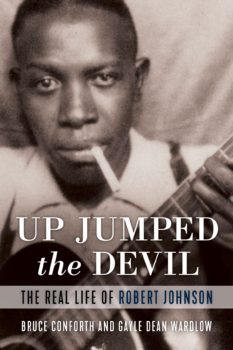Up Jumped the Devil, The Real Life Of Robert Johnson: Book Review
Up Jumped the Devil, The Real Life Of Robert Johnson
Bruce Conforth and Gayle Dean Wardlow, Chicago Review Press 2019
This is the book that many blues fans, musicians and musical scholars thought would never appear, but finally is in our hands 82 years after his death.
Up Jumped the Devil, The Real Life Of Robert Johnson has nothing to do with the tedious legend that bedevils his story. The selling of the soul, the crossroads, the tortured genius. A fellow who apparently had a lot of trouble with women, as the liner notes to the first collection of his music states.
 Of the authors, Gayle Dean Wardlow is a legendary blues historian with a famous collection of original 78 blues records. Bruce Conforth has been a professor of American history and popular culture. He also was a founding curator of the Rock and Roll Hall of Fame. This is the culmination of over 50 years of research, interviews and tracing of original documents and press articles.
Of the authors, Gayle Dean Wardlow is a legendary blues historian with a famous collection of original 78 blues records. Bruce Conforth has been a professor of American history and popular culture. He also was a founding curator of the Rock and Roll Hall of Fame. This is the culmination of over 50 years of research, interviews and tracing of original documents and press articles.
The search for the real Robert Johnson became an epic of Homeric proportions. There is the infamous and semi-legendary Mack McCormick, who interviewed Johnson’s sister and other contacts in the early seventies. He apparently investigated Johnson’s death to a forensic level, but became very secretive. A book was promised, Biography of a Phantom, which never appeared and he ended up behaving very oddly.
With thorough historical research, and interviews with as many relatives, girlfriends, partners male and female and music business associates as could be traced, Wardlow and Conforth present as complete and true a picture of Johnson’s life as will ever be achieved. And it’s a revelation as to how startling and fresh it appears, as it is only now that we finally get to see the real man.
The authors state that almost every previous known fact about his life was erroneous. I found it fascinating how it resonates with the early life of Elvis Presley as documented by the later and much better researched biographies like Peter Guralnick.
Johnson was born to Noah and Julia Majors. When they parted ways, she formed a relationship with Charles Dodds, and it is this family which is the key to Roberts early life and development. He had step-brothers and sisters, one of which taught him piano.
He was able to get an education, uncommon for a majority of blacks in the American South in the early 1900s. Education set him apart from his birth fathers’ family, who were sharecroppers, though he often ended up in the fields, rebelled, got thrashings. He kept a notebook and wrote down lyrics. It was becoming obvious in his teens that he was a prodigy.
Johnson saw guitarists like Son House, saw how they could make money, be respected and envied. It wasn’t hard to spot the attraction of young women to these men.
The role of Isiah Zimmerman who was his musical mentor is revealed from interviews with Zimmerman’s daughter. This is reminiscent of Hank Williams and Bill Monroe, and their key black musical mentors.
If Bob Dylan had known this, he may not have changed his name. Possibly this is where the legend of selling his soul may have originated. Zimmerman used to like practicing in the nearby cemetery.
Johnson saw Charley Patton play a number of times. Patton was a genius of extraordinary rhythmic complexity and technique combined with theatrics and showmanship. He was the Jimi Hendrix and James Brown of his time rolled into one. Johnson refined and simplified his music, smoothed out his technique. In the same way Michael Jackson took from Brown.
The environment of Black America in the South in the first quarter of the century is brought to the foreground. Picture Johnson arriving in San Antonio by bus the day prior to his debut recording session. His first time in Texas, he is given strict instructions not to go out of the boarding house as he is Black.
He goes out anyway, gets a severe beating by several policemen. His guitar is smashed. He is locked in the police holding cells. He is able to call his recording producer, Don Law, to get him out. The next day he entered the hotel where they were recording, through the back service entrance as blacks aren’t allowed through the front door.
Kind Hearted Woman, Dust my Broom, Sweet Home Chicago, Ramblin’, When You Got a Good Friend, Come on in My Kitchen were then recorded in that sequence. Masterpieces and foundations for rhythm and blues and soul music.
This is an essential book for anyone who has any passion or interest in the music which has originated out of America.
Along with the classic of American literature, Mystery Train, Images of America in Rock’n’Roll Music by Greil Marcus, we have the crucial portrait of the artist as a young man, dead less than two years after that first recording session.
Rev Orange Peel
- No Broadcast – The Common Thread (Album Review) - May 14, 2023
- Rita Mae – Whammy Bar, May 5, 2023 (Concert Review) - May 6, 2023
- Dictaphone Blues – Greetings from Glen Eden (EP Review) ⭐⭐⭐ - May 4, 2023
